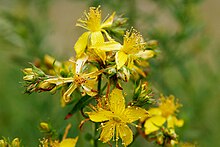| Hypericaceae Temporal range: Eocene–recent PreꞒ Ꞓ O S D C P T J K Pg N Possible Late Cretaceous record | |
|---|---|

| |
| Hypericum tetrapterum | |
| Scientific classification | |
| Kingdom: | Plantae |
| Clade: | Tracheophytes |
| Clade: | Angiosperms |
| Clade: | Eudicots |
| Clade: | Rosids |
| Order: | Malpighiales |
| Family: | Hypericaceae Juss. |
| Genera | |
|
See text | |
Hypericaceae is a plant family in the order Malpighiales, comprising six to nine genera and up to 700 species, and commonly known as the St. John's wort family. Members are found throughout the world apart from extremely cold or dry habitats. Hypericum and Triadenum occur in temperate regions but other genera are mostly tropical.
Characteristics
Members of this family are annual or perennial herbs, subshrubs or shrubs. The leaves are simple and entire, in opposite pairs; they are sometimes dotted with black or translucent glandular spots. The inflorescence consists of a branched, flat-topped cluster, each flower being radially symmetrical, with a superior ovary. Flowers have the following components: sepals, four or five, which tend to persist; petals four or five, usually yellow, sometimes dotted with black specks; stamens many, on long filaments; styles, three to five, often fused at the base. The fruit has a dehiscent capsule which splits open when ripe to release the fine black seed.
Taxonomy
At one time, this family was accepted as a subfamily of the family Clusiaceae. Now it has been elevated to full family status. In Phytotaxa, six genera and around 590 species are listed, whereas The Plant List recognises nine genera and around 700 species. Members of the family are found worldwide except in excessively cold or dry areas. Most of the genera are mainly tropical, but Hypericum and Triadenum are found in temperate regions. Molecular data supports the monophyly of Hypericaceae.
When accepted as a complete family, the cladogram of Hypericaceae would appear as such:
| Hypericaceae |
| |||||||||||||||||||||||||||||||||||||||||||||
Pharmacology

Many members of this family contain the naphthodianthrone derivatives hypericin and pseudohypericin; these are contained in glandular tissues that appear as black, orange or translucent spots or lines on petals, leaves and other parts of the plant. These compounds are photosensitive and can cause reactions in grazing animals, such as blistering of the muzzle, as well as in people who come into contact with the plants over prolonged periods. The highest concentration of these substances occurs in common St. John's wort (Hypericum perforatum), which is used in herbalism and as a folk remedy.
References
- "Malpighiales". www.mobot.org. Retrieved 16 June 2023.
- Angiosperm Phylogeny Group (2009). "An update of the Angiosperm Phylogeny Group classification for the orders and families of flowering plants: APG III" (PDF). Botanical Journal of the Linnean Society. 161 (2): 105–121. doi:10.1111/j.1095-8339.2009.00996.x. Retrieved 8 October 2021.
- "Hypericaceae (St. John's-wort) family". Go Botany. New England Wildflower Society. Retrieved 17 June 2018.
- Christenhusz, M. J. M.; Byng, J. W. (2016). "The number of known plants species in the world and its annual increase". Phytotaxa. 261 (3): 201–217. doi:10.11646/phytotaxa.261.3.1.
- ^ Robson, Norman K.B. "Hypericaceae Jussieu: St John's Wort Family". Flora of North America. Retrieved 17 June 2018.
- Kenneth J. Wurdack; Charles C. Davis (2009), "Malpighiales phylogenetics: Gaining ground on one of the most recalcitrant clades in the angiosperm tree of life", American Journal of Botany, 96 (8): 1551–1570, doi:10.3732/ajb.0800207, PMID 21628300, S2CID 23284896
- "St. John's Wort". National Center for Complementary and Integrative Health, US National Institutes of Health. September 2016. Retrieved 17 June 2018.
External links
- Hypericaceae of Mongolia in FloraGREIF Archived 4 March 2016 at the Wayback Machine
| Taxon identifiers | |
|---|---|
| Hypericaceae |
|